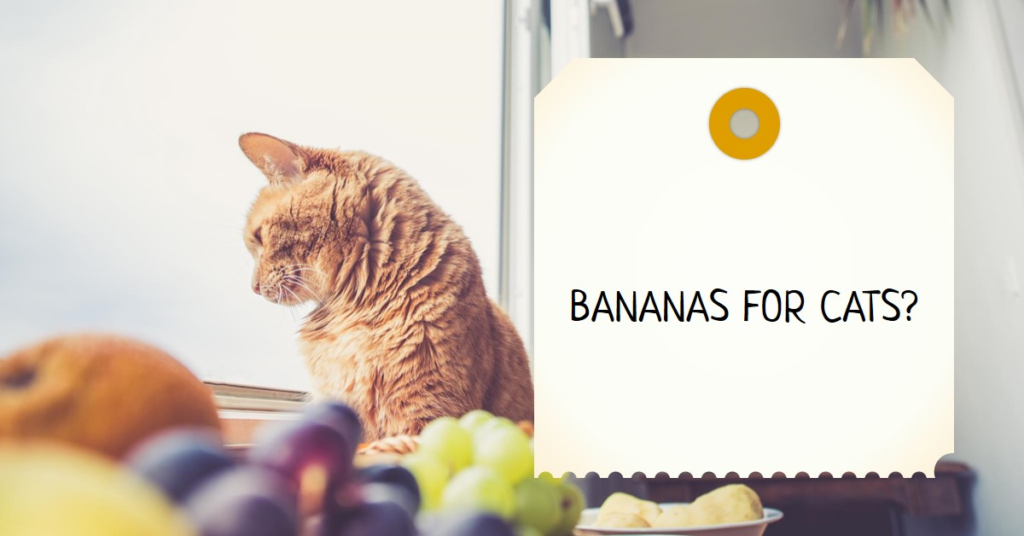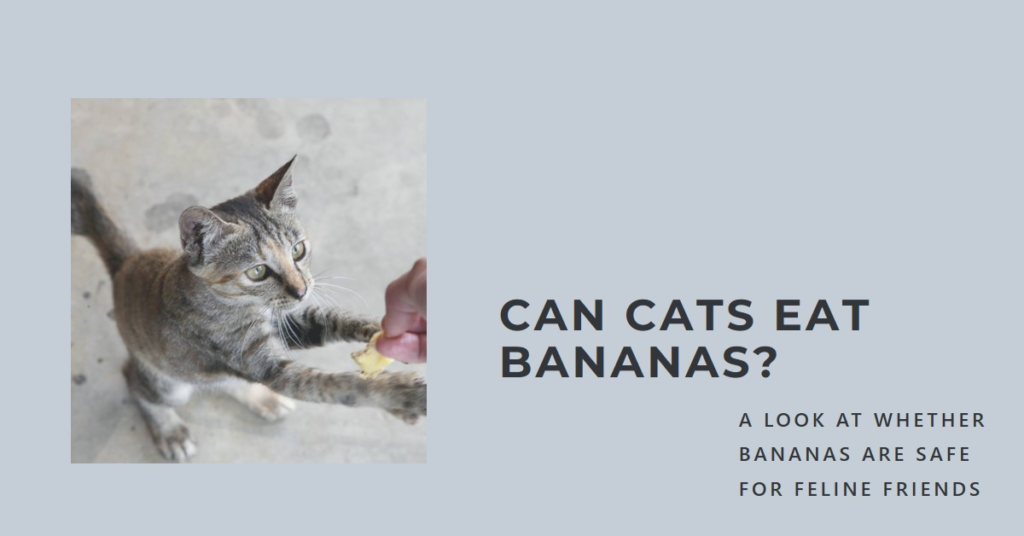Cats are commonly kept as pets globally. People often wonder if their feline friends can enjoy the same food items humans consume. Bananas contain high water content and are low in fat and calories, making them a healthy snack. For many pet owners, the question arises – can cats enjoy bananas like their human families do? As one of the world’s most popular fruits, bananas are sweet and nutritious.
However, with cats’ smaller bodies than humans, special care is needed when considering their fruit intake. This article will explore can cats eat bananas and investigate safe amounts guidelines. Both benefits and risks will be outlined so readers can make informed decisions for their furry friends.
Can cats eat bananas?

In small and limited quantities, cats can eat bananas in moderation. Bananas are soft and sweet, and cats generally like their taste. They provide several important cat nutrients, such as potassium, magnesium, vitamin C, and B6. However, due to their high natural sugar content, bananas should not become a staple of cats’ diet and must be fed occasionally as a treat only.
Nutritional value of bananas for cats
Bananas provide many health benefits for cats. They are high in potassium, which regulates heart rate and blood pressure. Bananas also contain prebiotic fiber that supports the digestive health of cats. Vitamin C acts as an antioxidant and helps in the absorption of iron. Bananas B6 helps cats’ red blood cell production and brain function and convert food to energy.
How many bananas can cats eat?
Feeding bananas in moderation is important as cats’ stomachs are smaller than humans’. A general guideline is to give cats 1-2 small pieces of banana per feeding as a treat, depending on the cat’s size. This means about 1/4 to 1/2 inch of banana. Feeding too much at once may cause stomach upset, vomiting, or diarrhea in some cats. The high natural sugar in bananas can also cause changes in insulin levels if fed excessively. So, it’s vital not to overdo the quantities.
How often can cats be given bananas?

Bananas should be fed to cats only occasionally rather than daily. A good frequency is 1-2 times a week as a treat only. This allows cats to benefit from the nutrients without overdoing the sugar.
Even in small portions, too much sugar can disrupt the pH levels of cats’ digestive systems if consumed frequently. It’s always best to check with your vet based on your cat’s needs, age, and medical conditions. Moderation is key when including bananas in the feline diet.
Precautions while feeding bananas
Some precautions need to be followed for the safety of cats. Banana skin should never be fed as it could cause an intestinal blockage in cats. The banana must be peeled, and any seeds must be removed before feeding.
Bananas should be given to cats as treats only and not replace their normal cat food to avoid unbalanced nutrition. It’s a good idea to monitor cats after eating bananas in case of an adverse reaction like diarrhea or vomiting.
Potential alternatives for intolerant cats
While many cats do well with bananas in moderation, not all tummies are created equal. Symptoms like persistent diarrhea or loss of appetite may not agree with that individual.
In these cases, other options exist containing similar nutrition profiles, such as pumpkin, watermelon, cantaloupe, or sweet potato, in very small, monitored portions. Always listen to our furry friends’ bodies and refrain from anything distressing their comfort. Their well-being comes first.
Alternatives if cats don’t tolerate bananas
Some cats may be unable to digest bananas due to individual intolerance or medical conditions. In such cases, safe alternatives as occasional treats include very small pieces of watermelon, pumpkin, blueberries, melon, etc. These contain minerals, vitamins, and fiber that benefit feline health.
Your cat must show any signs of an upset stomach after eating bananas. Their comfort should be the priority over an occasional treat. Always consult your veterinarian for the best treatment options.
How frequently should bananas be offered as treats?
While bananas offer nutrition, their natural sugars could cause issues if fed too often. About 1-2 times per week maximum is generally recommended. This allows cats to enjoy the flavor without impacting their metabolisms. Feeding times should also be spaced out, not one right after the other. Changes like this help prevent digestive disturbances from occurring. The priority is keeping tummies calm and comfortable.
How much banana is appropriate per feeding?
With their smaller stomach sizes than humans, overindulging could upset a cat’s tummy. It’s best to start by giving only a small piece of banana, about half the size of a grown man’s pinky fingernail.
Wait and see how their body reacts before considering slightly more the next time. Bigger cats may tolerate a larger thumbnail-size piece. If vomiting, diarrhea, or loss of appetite occurs, avoiding bananas with that individual is safer. Moderation is key to happy digestion.
Benefits of potassium from bananas for cats
Potassium is essential for cats’ heart, muscle, and nerve function. It regulates blood pressure and electrolyte balance. Bananas are excellent sources of potassium, containing over 400mg per 100g of fruit.
For cats, consuming bananas’ potassium supports a healthy cardiovascular system. It may also mitigate long-term stroke and heart disease risks when consumed occasionally as a balanced diet. Bananas nourish feline athletes, too, aiding muscle contractions during play or exercise.
Their high water content further boosts hydration when potassium is lost through activity and panting. Overall, bananas’ potassium provisions improve our four-legged companions’ physical wellness.
The prebiotic fiber in bananas fosters digestion
Soluble fiber in bananas feeds the healthy microbiota in cats’ intestinal tracts. These beneficial bacteria secrete byproducts that facilitate smooth bowel movements while absorbing toxins. This creates an optimally functioning digestive environment.
Banana’s fiber additionally makes cats feel fuller for longer by absorbing water during the passage through the bowels. The gel-like content delays stomach emptying, promoting healthier bathroom breaks.
With bananas being a snack many felines thoroughly enjoy, the prebiotic aspects make for happy tummies with reduced constipation from alternate treats higher in undesirable fats or salts. Fibre is nature’s antibiotic-promoting, promoting infection-free colons in our companions.
Conclusion
Cats can eat bananas in moderation as an occasional treat, not in large quantities or frequently. It provides cats with excellent nutrients, and many enjoy its sweet taste. However, like all new foods, cats must be monitored when introducing bananas for any reactions. It’s not a replacement for cat food; precautions must be followed for feline safety. Including bananas in a cat diet sensibly can be a healthy treat cats enjoy now and then.
Frequently Asked Questions (FAQs)
Q: Can cats eat the banana peel?
A: No, banana peels should not be fed to cats due to the risk of intestinal Blockage. The flesh inside is fine, but peels could be dangerous.
Q: How young can kittens have bananas?
A: Kittens under six months old should avoid bananas because they risk choking or tummy upset from rich plant fibers in their developing systems.
Q: Can diabetic cats eat bananas?
A: Yes, but only in very small portions and monitored closely by guardians, as bananas contain natural sugar, which could spike blood sugar levels if overindulged.
Q: What if my cat is allergic to bananas?
A: If symptoms like itchiness, vomiting, or diarrhea occur, discontinue banana treats and consider alternatives without reaction. Consult a vet if necessary.
Q: How do I introduce bananas to my cat?
A: Start with a tiny piece and watch for signs of intolerance before slightly increasing the amount each time over one to two weeks to allow gut adjustment. Go slow for a safe introduction.
Also Read:
- Best Dog Grooming Tips for Matted Hair in 2024
- Best and Safest Chew Toys For Dogs in 2024
- Best Grooming Tips for Long Haired Cats


